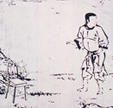A Short Correspondents Course
The Zapruder film proved beyond question that a conspiracy was behind the murder. Yet the general public didn’t have a chance to watch that film as a motion picture until 1975. True, Life magazine had published a few selected stills from the movie. However, the movie is nearly 500 frames long. A series of disconnected, individual images simply doesn’t convey motion, which is what movies are all about. When the Zapruder film is seen as a motion picture, the effect is visceral. I can still recall the collective gasp of the studio audience when they saw the President’s head thrown back and to the left in a spray of blood.
But in 1975, Rivera had already been marginalized by his sensationalist style. The assassination itself had been marginalized, and the film really didn’t tell people anything they didn’t already suspect. It wasn’t a big story anymore.
Besides, big stories that lack official validation don’t “make” media careers; they tend to damage careers. Newsweek reporter Robert Parry broke the U.S.-Iran-contra story. The government denied it, and Parry lost his job. As it turned out, Parry was right; but he didn’t get his old job back. San Jose Mercury reporter Gary Webb cracked the U.S.-contra-cocaine connection. The paper back-tracked under political pressure; Webb was transferred to the suburbs to report on high school sports. Now, consider Bob Woodward and the Watergate scandal. Navy lieutenant Woodward had served in the Nixon White House before he abandoned his promising career to become a reporter. He was a rookie on the metro beat of the Washington Post when he landed a small story that turned into a huge one. As luck would have it, he had a secret source in the White House codenamed Deep Throat.
Robert MacNeil, of P.B.S. MacNeil/Leher news fame, was a younger man once. He worked for N.B.C. in 1963; he was on the press bus in Kennedy’s fateful motorcade. He heard shots and he got off the bus. He was photographed along with several other people at the west end of the grassy knoll, looking at the railroad tracks that ran by Dealey Plaza. He walked around; he talked to people. In search of a pay phone, he requested directions from a young man leaving the Texas School Book Depository who directed MacNeil to the building across the street. That young man apparently was the alleged assassin. MacNeil later suspected that a conspiracy had taken Kennedy’s life, but N.B.C. didn’t agree.
Retired C.B.S. newsman Dan Rather was younger once. He was on the west side of the railroad tracks when Kennedy was shot. Rather was involved in C.B.S.’s attempt to buy the Zapruder film the next day. He was the only reporter who saw the movie before it was “disappeared” for a dozen years. He described it on the air for C.B.S. Although his location at the time of the shooting and his viewing of the Zapruder film made him a potentially critical witness, Rather was not called to testify by the presidential commission investigating the murder.
After Rivera broadcast the film, Rather was criticized for his 1963 account. In fact, he had reported details which do not appear in the film as we know it today. What could he do? Forced to reconcile his memory of 1963 with the extant movie in 1975, he conceded that he must have made some mistakes. Decades later, when puzzling documents on George Bush, Jr.’s Air National Guard service emerged, Rather was again attacked for apparent mistakes.
I once thought that Dan Rather lied in 1963. Now, I think he told the truth, which might be why he wasn’t called as a witness. Today, it’s the movie I question. I think that in 1975, Rather held unfounded assumptions about that film, as most people did, including myself.
The same kinds of forces which frustrated public understanding in 1963 live on in 2007. Major events still touch people in a myriad of ways.
Rivera’s 1986 special about the excavation of a tunnel in Chicago once used by the Capone gang was a dud. Al Capone’s secret “vault” held nothing more than dirt and a bottle of gin. On the other hand, I found Rivera’s reports from New Orleans after hurricane Katrina genuinely moving. Nevertheless, he is a strident voice on the right. As a FOX war correspondent in 2001, he proclaimed he was “[i]tching for justice, or maybe just revenge.” He was a strong supporter of the invasion of Iraq, and he was criticized for some of his reports. On a radio program in Florida last December, after mumbling about a “midget” and a “slimeball,” he announced that he was ready to fight M.S.N.B.C. newsman Keith Olbermann! Rivera said he would make a pizza out of Olbermann.
Olbermann responded in part by saying that he could remember when Rivera used to be somebody. I can, too.
____________________
Labels: Abraham Zapruder, Bob Woodward, Dan Rather, Dick Gregory, Gary Webb, Geraldo Rivera, Keith Olbermann, Robert MacNeil, Robert Parry


